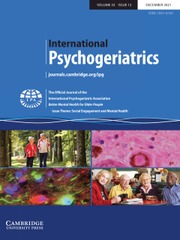Crossref Citations
This article has been cited by the following publications. This list is generated based on data provided by
Crossref.
Meeks, Thomas W.
Lanouette, Nicole
Vahia, Ipsit
Dawes, Sharon
Jeste, Dilip V.
and
Lebowitz, Barry
2009.
Psychiatric Assessment and Diagnosis in Older Adults.
Focus,
Vol. 7,
Issue. 1,
p.
3.
Jorge, Ricardo E.
Robinson, Robert G.
and
O'Brien, John T.
2009.
TOP CITED PAPERS IN INTERNATIONAL PSYCHOGERIATRICS: 5. A CONTROLLED STUDY OF REPETITIVE TRANSCRANIAL MAGNETIC STIMULATION AS A TREATMENT OF DEPRESSION IN THE ELDERLY.
International Psychogeriatrics,
Vol. 21,
Issue. 5,
p.
855.
Lyness, Jeffrey M.
Yu, Qin
Tang, Wan
Tu, Xin
and
Conwell, Yeates
2009.
Risks for Depression Onset in Primary Care Elderly Patients: Potential Targets for Preventive Interventions.
American Journal of Psychiatry,
Vol. 166,
Issue. 12,
p.
1375.
2009.
Current awareness in geriatric psychiatry.
International Journal of Geriatric Psychiatry,
Vol. 24,
Issue. 8,
Grabovich, Andrew
Lu, Naiji
Tang, Wan
Tu, Xin
and
Lyness, Jeffrey M.
2010.
Outcomes of Subsyndromal Depression in Older Primary Care Patients.
The American Journal of Geriatric Psychiatry,
Vol. 18,
Issue. 3,
p.
227.
Santos, M.
Gold, G.
Kövari, E.
Herrmann, F. R.
Hof, P. R.
Bouras, C.
and
Giannakopoulos, P.
2010.
Neuropathological analysis of lacunes and microvascular lesions in late-onset depression.
Neuropathology and Applied Neurobiology,
Vol. 36,
Issue. 7,
p.
661.
Hermida, Adriana P.
and
McDonald, William M.
2010.
Principles and Practice of Geriatric Psychiatry.
p.
565.
Phelan, Elizabeth
Williams, Barbara
Meeker, Kathryn
Bonn, Katie
Frederick, John
LoGerfo, James
and
Snowden, Mark
2010.
A study of the diagnostic accuracy of the PHQ-9 in primary care elderly.
BMC Family Practice,
Vol. 11,
Issue. 1,
Robinson, DJ
O'Luanaigh, C
Tehee, E
O'Connell, H
Hamilton, F
Chin, AV
Coen, R
Molloy, AM
Scott, J
Cunningham, CJ
and
Lawlor, BA
2011.
Associations between holotranscobalamin, vitamin B12, homocysteine and depressive symptoms in community‐dwelling elders.
International Journal of Geriatric Psychiatry,
Vol. 26,
Issue. 3,
p.
307.
Sanders, Joost B.
Bremmer, Marijke A.
Comijs, Hannie C.
Deeg, Dorly J.H.
Lampe, Indrag K.
and
Beekman, Aartjan T.F.
2011.
Cognitive Functioning and the Natural Course of Depressive Symptoms in Late Life.
The American Journal of Geriatric Psychiatry,
Vol. 19,
Issue. 7,
p.
664.
Baghai, Thomas C.
Blier, Pierre
Baldwin, David S.
Bauer, Michael
Goodwin, Guy M.
Fountoulakis, Kostas N.
Kasper, Siegfried
Leonard, Brian E.
Malt, Ulrik F.
Stein, Dan
Versiani, Marcio
and
Möller, Hans-Jürgen
2011.
General and comparative efficacy and effectiveness of antidepressants in the acute treatment of depressive disorders: a report by the WPA section of pharmacopsychiatry.
European Archives of Psychiatry and Clinical Neuroscience,
Vol. 261,
Issue. S3,
p.
207.
Goveas, Joseph S.
Espeland, Mark A.
Hogan, Patricia
Dotson, Vonetta
Tarima, Sergey
Coker, Laura H.
Ockene, Judith
Brunner, Robert
Woods, Nancy F.
Wassertheil-Smoller, Sylvia
Kotchen, Jane M.
and
Resnick, Susan
2011.
Depressive symptoms, brain volumes and subclinical cerebrovascular disease in postmenopausal women: The Women's Health Initiative MRI Study.
Journal of Affective Disorders,
Vol. 132,
Issue. 1-2,
p.
275.
Meeks, Thomas W.
Vahia, Ipsit V.
Lavretsky, Helen
Kulkarni, Ganesh
and
Jeste, Dilip V.
2011.
A tune in “a minor” can “b major”: A review of epidemiology, illness course, and public health implications of subthreshold depression in older adults.
Journal of Affective Disorders,
Vol. 129,
Issue. 1-3,
p.
126.
Mesholam-Gately, R. I.
Giuliano, A. J.
Zillmer, E. A.
Barakat, L. P.
Kumar, A.
Gur, R. C.
McAndrew, L. M.
Bilker, W. B.
Elderkin-Thompson, V.
and
Moberg, P. J.
2012.
Verbal Learning and Memory in Older Adults with Minor and Major Depression.
Archives of Clinical Neuropsychology,
Vol. 27,
Issue. 2,
p.
196.
Cherubini, Antonio
Nistico, G.
Rozzini, R.
Liperoti, R.
Di Bari, M.
Zampi, E.
Ferrannini, L.
Aguglia, E.
Pani, L.
Bernabei, R.
Marchionni, N.
and
Trabucchi, M.
2012.
Subthreshold depression in older subjects: An unmet therapeutic need.
The Journal of nutrition, health and aging,
Vol. 16,
Issue. 10,
p.
909.
Vahia, Ipsit V.
Thompson, Wesley K.
Depp, Colin A.
Allison, Matthew
and
Jeste, Dilip V.
2012.
Developing a dimensional model for successful cognitive and emotional aging.
International Psychogeriatrics,
Vol. 24,
Issue. 4,
p.
515.
Ohaeri, Jude U.
and
Awadalla, Abdel W.
2012.
Characteristics of subjects with comorbidity of symptoms of generalized anxiety and major depressive disorders and the corresponding threshold and subthreshold conditions in an Arab general population sample.
Medical Science Monitor,
Vol. 18,
Issue. 3,
p.
CR160.
Büchtemann, Dorothea
Luppa, Melanie
Bramesfeld, Anke
and
Riedel-Heller, Steffi
2012.
Incidence of late-life depression: A systematic review.
Journal of Affective Disorders,
Vol. 142,
Issue. 1-3,
p.
172.
Mackin, R. Scott
Insel, Philip
Aisen, Paul S.
Geda, Yonas E.
and
Weiner, Michael W.
2012.
Longitudinal stability of subsyndromal symptoms of depression in individuals with mild cognitive impairment: relationship to conversion to dementia after 3 years.
International Journal of Geriatric Psychiatry,
Vol. 27,
Issue. 4,
p.
355.
Steffen, Ann M.
and
Mangum, Kristin R.
2012.
Predicting Attendance at Dementia Family Support Groups.
American Journal of Alzheimer's Disease & Other Dementias®,
Vol. 27,
Issue. 8,
p.
633.

